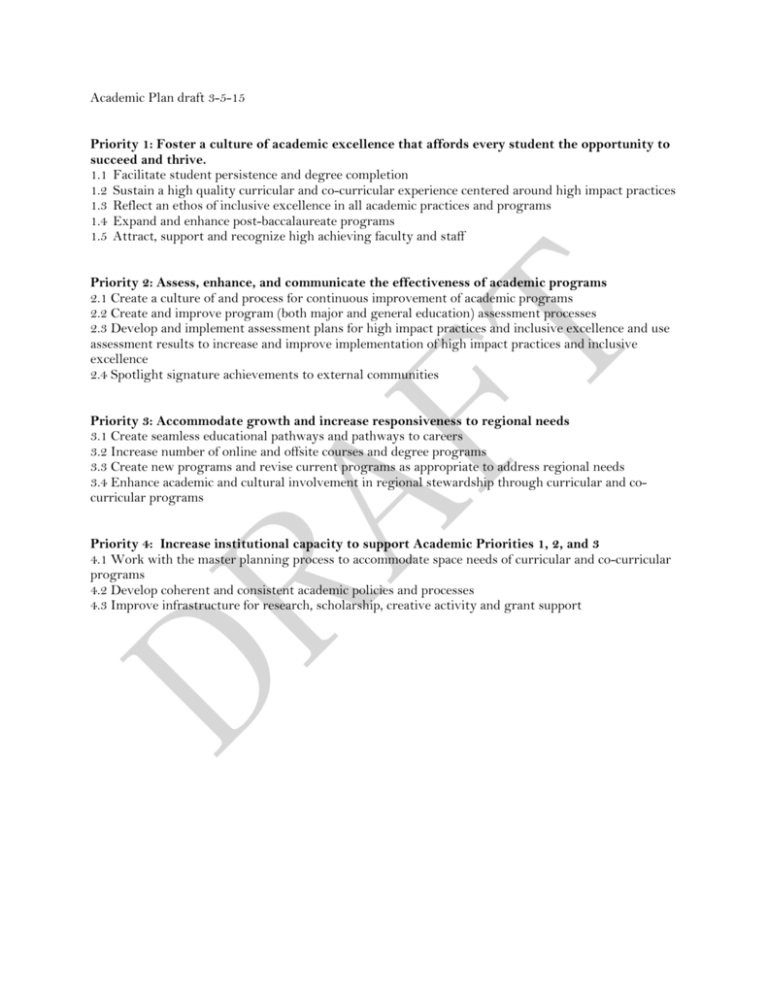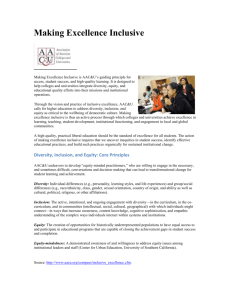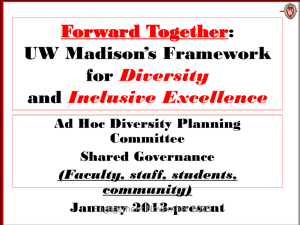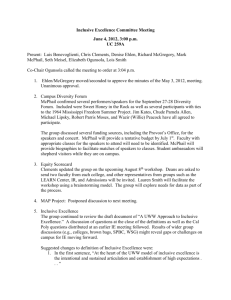the Draft Academic Plan Here
advertisement

Academic Plan draft 3-5-15 Priority 1: Foster a culture of academic excellence that affords every student the opportunity to succeed and thrive. 1.1 Facilitate student persistence and degree completion 1.2 Sustain a high quality curricular and co-curricular experience centered around high impact practices 1.3 Reflect an ethos of inclusive excellence in all academic practices and programs 1.4 Expand and enhance post-baccalaureate programs 1.5 Attract, support and recognize high achieving faculty and staff Priority 2: Assess, enhance, and communicate the effectiveness of academic programs 2.1 Create a culture of and process for continuous improvement of academic programs 2.2 Create and improve program (both major and general education) assessment processes 2.3 Develop and implement assessment plans for high impact practices and inclusive excellence and use assessment results to increase and improve implementation of high impact practices and inclusive excellence 2.4 Spotlight signature achievements to external communities Priority 3: Accommodate growth and increase responsiveness to regional needs 3.1 Create seamless educational pathways and pathways to careers 3.2 Increase number of online and offsite courses and degree programs 3.3 Create new programs and revise current programs as appropriate to address regional needs 3.4 Enhance academic and cultural involvement in regional stewardship through curricular and cocurricular programs Priority 4: Increase institutional capacity to support Academic Priorities 1, 2, and 3 4.1 Work with the master planning process to accommodate space needs of curricular and co-curricular programs 4.2 Develop coherent and consistent academic policies and processes 4.3 Improve infrastructure for research, scholarship, creative activity and grant support Priority 1: Foster a culture of academic excellence that affords every student the opportunity to succeed and thrive. 1.1 Facilitate student persistence and degree completion Targets: Increase six-year graduation rate by ___% Preserve equal graduation rates among all student demographics Strategies: Institute mandatory advising at crucial points in student’s academic career Create more flexibility within majors to allow for more student choice and fewer high stakes courses 1.2 Sustain a high quality curricular and co-curricular experience centered around high impact practices Targets: Increase study abroad/NSE participation by __% Increase undergraduate research participation by __% Strategies: Identify potential study abroad/NSE destinations for each degree program Increase student participation in academic and cultural events on campus and in the community Devise ways to appropriately scaffold high impact practices and connect them to one another Create a framework to design and support multidisciplinary programs 1.3 Reflect an ethos of inclusive excellence in all academic practices and programs Targets: Strategies: Expand faculty peer mentoring programs Provide workshops in inclusive pedagogies 1.4 Expand and enhance post-baccalaureate programs Targets: Develop at least one new viable graduate program in each college Increase graduate enrollments by ___% Strategies: Complete post-baccalaureate program handbook Devise strategy for better tracking of credential students Conduct market research and needs assessment for graduate offerings 1.5 Attract, support and recognize high achieving faculty and staff Targets: Increase tenure density to a minimum of 50% Eliminate faculty salary inversion issues within colleges Strategies: Create a recognition framework for faculty, staff, and unit achievements Provide search committee outreach training in inclusive excellence Develop campus-based salary equity plan Expand teaching and learning development opportunities Create a campus-based leadership development program Priority 2: Assess, enhance, and communicate the effectiveness of our academic programs 2.1 Create a culture for continuous improvement of academic programs Targets: Increase the number of faculty involved with collaborative assessment of student work Strategies: - Create and promote assessment slogan (e.g. At CSUMB Teaching is Community Property) - Promote discussion of meaning and integrity of degrees across AA and SA - Provide assessment workshops/training for faculty - Require faculty to submit student work for program and institutional assessment and create the infrastructure to make that easy to do (e.g. eportfolios) 2.2 Create and improve program (both major and general education) assessment processes Targets: 100% of departments will submit annual program assessment reports and program review on time Strategies: - Create annual program assessment manual and review program review manual to meet current best practices including curricular maps, assessment plans - Streamline and align annual program assessment and program review reports - Base GE recertification on assessment results - Base program funding decisions on assessment results 2.3 Develop and implement assessment plans for high impact practices and inclusive excellence and use assessment results to increase and improve implementation of high impact practices and inclusive excellence Targets: 100% of programs using high impact practice will submit annual assessment reports; 100% of programs will incorporate inclusive excellence in the curriculum (see diversity report) Strategies: - Programs to include FYS, Capstone, Service Learning, Study Abroad, Writing - Identify methods for capturing data on high impact practices and inclusive excellence including support of the data warehouse and dashboards - Produce regular reports on numbers of courses and curricula incorporating 2.4 Communicate signature achievements to external Communities Targets: 100% of colleges will maintain an inventory of notable achievements Strategies: Create template for the submission of items of note to colleges Create regularized reporting of achievements to university communications Priority 3: Accommodate growth and increase responsiveness to regional needs 3.1 Create seamless educational pathways and pathways to careers Target A: Increase local community college transfer admits by __% Strategies: Establish Transfer Student Success Center. Clearly articulate curricula between community colleges and CSUMB in specific, high demand programs Create 2 programs using CSIT in 3 model. Target B: Increase admission of FTF, local resident admits to __% Strategies: Create staff-supported Commuter Lounge that replicates resident hall support. Clearly articulate math and writing expectations between CSUMB and high schools in region. 3.2 Increase number of online and offsite courses and degree programs Targets: Double online and off-site course enrollment, current number is ____ Increase self-support offerings by __% Increase summer online & off-site offerings by __% Strategies: Establish a series of workshops to train faculty in online course delivery Establish a fund to convert appropriate F2F courses to online deliviery Create a Strategic Plan backed by data for adding a new undergraduate and graduate program each year for the next five years (either live or online) Add an academic program in Salinas as a general studies or business degree completion program. Supplement offerings through online and comprised video offerings. 3.3 Create new academic programs and make adjustments in current programs to address regional needs Targets: Develop more flexible curriculum - specifically target rigid majors and high-unit courses. o Target 20% reduction in 4-unit courses per Program. Develop a General Studies degree program o Degree completion for working adults (Extended Ed) o undergraduate students who are stuck in major. 3.4 Enhance academic and cultural involvement in regional stewardship through curricular and cocurricular programs Targets: 100% of Upper Division Service Learning experiences connected to students’ major. Strategies: Develop cohesive service learning programs Ensure that Service Learning is related to major. Expand role of UROC to encompass professional programs Develop applied and community-based research programs with community partners Priority 4: Increase institutional capacity to support Academic Priorities 1, 2, and 3 4.1 Work with the master planning process to accommodate space needs of curricular and co-curricular programs Targets: Strategies: Plan academic building 3 4.2 Develop coherent and consistent academic policies and processes 4.3 Improve infrastructure for research, scholarship, creative activity and grant support Targets: Increase the total number of PIs from across campus submitting proposals by __% Increase the total number of faculty and students involved in externally funded research by__% Increase the total number of faculty and student publications/exhibits by __% Increase the number of grant proposals with cross College and/or Division involvement Strategies: Create a research, scholarship, and creative activity database Implement Kuali-Coeus software for eRA, internal proposal tracking, reporting and management. Create a Needs Assessment and Institutional Capacity Inventory on Research, Scholarship and Creative Activity Centralize research compliance coordination within the Sponsored Programs Office Provide workshops to expand the knowledge of faculty and staff in grant opportunities and development. Provide “Scholarly Writing Institutes” and/or “Write on site” programs Promote an environment supportive of developing and sustaining interest and involvement in external funding across ALL areas of the campus






